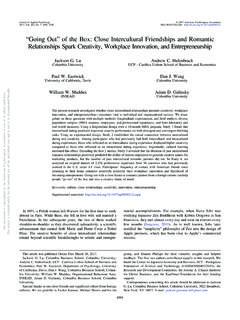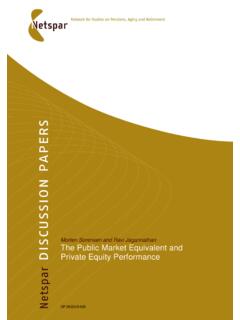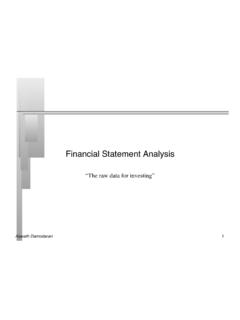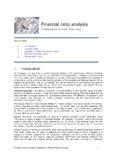Transcription of The Analysis of Cash Flows - Columbia Business School
1 Occasional paper SeriesON THE Analysis OF FIRMS CASH Flows Center for Excellence in Accounting & Security Analysis Columbia Business School established the Center for Excellence in Accounting and Security Analysis in 2003 under the direction of Trevor Harris and Professor Stephen Penman. The Center ( CEASA ) aims to be a leading voice for independent, practical solutions for financial reporting and security Analysis , promoting financial reporting that reflects economic reality and encourages investment practices that communicate sound valuations.
2 CEASA s mission is to develop workable solutions to issues in financial reporting and accounting policy; produce a core set of principles for equity Analysis ; collect and synthesize best thinking and best practices; disseminate ideas to regulators, analysts, investors, accountants and management; and promote sound research on relevant issues. Drawing on the wisdom of leading experts in academia, industry and government, the Center produces sound research and identifies best practices on relevant issues. CEASA's guiding criterion is to serve the public interest by supporting the integrity of financial reporting and the efficiency of capital markets.
3 Located in a leading university with a mandate for independent research, CEASA is positioned to lead a discussion of issues, with an emphasis on sound conceptual thinking and without obstacles of constituency positions. More information and access to current research is available on our website at The Center is supported by our generous sponsors: General Electric, IBM and Morgan Stanley. We gratefully acknowledge the support of these organizations that recognize the need for this center.
4 ON THE Analysis OF FIRMS CASH Flows James A. Ohlson; Carey Chair in Accountancy, School of Accountancy, Carey School of Business , Arizona State University Jagadison K. Aier; School of Accountancy, Carey School of Business , Arizona State University March 2007 Disclaimer The views expressed in this paper are those of the author and do not represent official positions of the Center for Excellence in Accounting and Security Analysis , or any of its Advisory Board or Directors Table of Contents 0 I.
5 1 II. WHY AN EVALUATION OF GAAP EARNINGS MOTIVATES A CASH Flows 3 III. A MODEL OF MODIFIED CASH ACCOUNTING (MCA).. 6 IV. THE MCA CASH EARNINGS STATEMENT AND QUALITY OF EARNINGS 14 V. THE GAAP STATEMENT OF CASH Flows AND THE MCA CASH EARNINGS 18 VI. CONCLUDING 19 20 Overview This paper revisits the whys and hows of cash Flows Analysis . The Analysis maintains a strict common shareholders perspective with an equity valuation focus. The paper argues that analysts turn to cash Flows to evaluate the potential ambiguity inherent in accruals.
6 The GAAP statement of cash Flows , however, (i) relies on a too narrow concept of cash and (ii) lacks a clear bottom-line directly comparable to net income per GAAP. To circumvent (i) and (ii), the paper proposes a framework of Modified Cash Accounting (MCA). A MCA statement of cash earnings satisfies a crucial property: It works like a regular income statement yet eschews all accruals. The paper discusses not only how one motivates and develops a MCA statement of cash earnings, but also how it should be put to use.
7 A crucial issue deals with how one compares the two bottom-lines -- GAAP income vs. that of MCA cash earnings -- given alternative growth scenarios. The paper shows how one can estimate a normal accrual , which can be added to MCA cash earnings, given assumptions about the firm s growth. I. Introduction Analysts generally view the income statement as the centerpiece of financial reporting. It supplies the primary data in the forecasting of subsequent periods earnings. To appreciate the primary data, the analyst must assess the impact of the underlying accounting principles on reported earnings: Not all components of earnings have the same predictive consequences.
8 Of particular concern is the distinction between accruals vs. cash Flows . Its mix influences the perceived quality of earnings .1 To sort out the effect of accruals vs. cash Flows and the quality of earnings, analysts naturally refer to the statement of cash When analysts undertake to evaluate GAAP s statement of cash Flows , new questions arise. First, it is unclear whether GAAP s narrow concept of cash is relevant. For example, one can construct economically equivalent transactions leading to different treatments in the cash flow statement.
9 Second, the dichotomy between operating and financial activities is arguably too arbitrary. For example, an increase in accounts payable could be viewed in substance as a financing rather than operating activity. Further, GAAP s way of assigning transactions to the three major categories (operating, investing, financing) can be challenged and Putting aside these classification problems, equity analysts still face a more basic issue. Unlike the income statement, the GAAP statement of cash Flows lacks a bottom-line.
10 While there seems to be a general consensus that cash from operations should provide the starting point, it is far from clear what analysts are supposed to do next. Neither text-books nor practice provide much of a guide. In other words, analysts lack access to a roadmap that takes them from the beginning of a cash Flows Analysis to the end. And the end ought to indeed correspond to a bottom-line, in a spirit no different from the way earnings correspond to a bottom-line for the income statement.



















